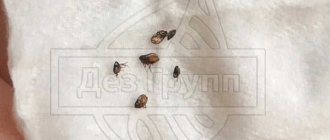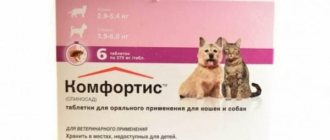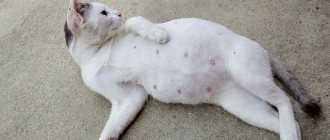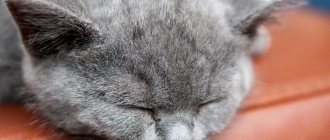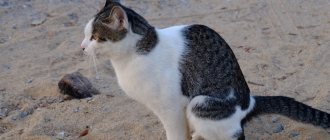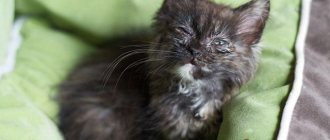Fleas make life miserable for pets, and people get itchy just thinking about the parasites. Veterinarians are often asked how to remove cat fleas from the house, what are the most effective tablets, drops, collars or shampoo for cats against fleas. As experts note, the answer to the question of how to get rid of cat fleas in an apartment and in a house lies in their biology.
There is no single method or insecticide that will completely eradicate (or at least control) these insects. The life cycle of a flea is quite complex. Only understanding the various stages of development will help get rid of them.
Let's look at what fleas are from a biological point of view.
Collectively, all flea species have a common scientific name - Siphonaptera. Cat fleas, Ctenocephalides felix, are the most commonly found flea in Russia. They parasitize cats, dogs, humans and other mammals and birds.
Fleas thrive in warm, moist environments and temperate climates. The main food is the blood of the host animal. Fleas are used as a host for mammals in 95% of cases. They can also infect birds (in 5% of cases).
Flea saliva, like other blood-sucking parasites, contains an ingredient that softens or "digests" the host's skin for easier penetration and feeding. Flea saliva is a strong irritant. All signs of an allergic reaction appear precisely against the background of its influence - it begins to itch, there is a desire to scratch, the skin burns, and the like.
Features of the insect
What are fleas? These are blood-sucking parasites. They are quite unpretentious and tenacious. Squashing a flea is not easy because of its body structure. The parasite has legs designed for jumping long distances. Fleas can go without food and survive for weeks this way. These insects are very prolific, which also poses a serious problem.
What do fleas look like and why are they dangerous?
Fleas have a mouthpart that allows them to bite through the skin of an animal and feed on its blood. Thanks to their laterally flattened body and small, rounded head, insects can move quickly through cat fur. On the surface of the flea's body there are bristly ridges, which also help the parasite cover distances on the animal's body. The flea has six legs, the back two of which are especially well developed. This allows fleas to jump up to half a meter.
These parasites pose a serious danger primarily to kittens, as well as weakened, sick and old animals. Fleas can cause anemia in kittens because one parasite drinks large amounts of blood. In the most advanced cases, fleas can lead to the death of the animal.
In addition to the fact that fleas feed on the blood of animals, they are also carriers of many dangerous diseases. For some types of helminths, fleas are an intermediate host. An animal can accidentally swallow a flea and then the helminth eggs enter the body directly, where they become larvae and then turn into adult parasites.
At the same time, the cat’s skin and fur also suffer greatly. The coat may fall out, lose shine and look unkempt.
Types of fleas in cats
The most common flea that affects cats is C felis, also known as the cat flea. The size of parasites of this species is small - from 2 to 4 mm. They do not have wings, and their small head and laterally flattened body allow them to easily move among the cat’s fur, clinging to the hairs with bristles and spines.
Where do fleas come from?
Fleas are parasites that are active all year round. They live not only on the street, but also in the basements of residential buildings and entrances. You may not even notice the larval eggs hidden in the corners of your apartment: behind baseboards, in cracks, in furniture and folds of linen. The larvae feed on dust and other contaminants, and then, upon reaching sexual maturity, migrate to a pet. Therefore, even a domestic cat can become infected with parasites that you accidentally brought from the street on your clothes or shoes.
Symptoms of flea infestation
You won't be able to avoid noticing fleas on your cat for a long time. The animal quickly begins to show the following signs of the disease:
- An infected cat begins to actively scratch and bite itself, trying to catch parasites.
- The animal is nervous and meows.
- Black crumbs on the skin are parasite excrement and dried blood from scratching bites.
- When examining the cat's back or scruff, you may notice bite marks.
- The presence of fleas themselves on the animal’s fur.
Are fleas the same on dogs and cats?
It happens that dogs and cats suffer from the same type of fleas. Dogs and cats can be parasitized by a specific type of parasite - the cat flea. At the same time, there is also a dog flea, which parasitizes exclusively on dogs.
How often can fleas be poisoned?
The procedure for killing fleas using special drops is carried out once. If necessary, the procedure is repeated after two months. At the same time, the room is treated with special means: the floor, baseboards and the animal’s sleeping area.
Causes of fleas in the house
Insects are often brought indoors from the street by a pet dog or cat, or by people on shoes, clothes, or in a bag of groceries.
Other common factors for fleas in the home include:
- movement of parasites through the ventilation system or cracks;
- entry from public corridors and entrances;
- from rodents;
- lack of hygiene, unsanitary conditions;
- dust that appears after major repairs.
The spread of fleas is often facilitated by dampness that occurs in apartment bathrooms and basements. Insects can move from attics and basements, especially if rodents have been poisoned there using chemicals. Therefore, parasites often attack apartments on the top or first floor.
Are fleas dangerous for humans?
Fleas can cause discomfort not only to pets, but also to humans. At times, parasites bother people by biting them, and any fears about this are not unfounded. After the bites of these parasites, unpleasant consequences can be observed on the skin in the form of blisters and papules. In addition, fleas can cause a skin infection in humans, which manifests itself in the form of ulcers or abscesses.
A person can become infected with helminthiasis by accidentally getting cat fleas into their mouth. The disease is asymptomatic in most cases.
Are cat fleas transmitted to humans? This depends on the gender and age of the pet. For example, a kitten's fleas are more likely to be transmitted to humans and begin to bite both the animal and its owner. Fleas are transmitted from cats to humans more often than from cats.
Actions after disinfestation
You should enter a cleaned and treated apartment after it has been thoroughly ventilated. Carry out wet cleaning of places that have to be touched, except for the floor. When sprayed, the chemical may accidentally get on door handles, armrests, or table surfaces. Treatment with a soap-soda solution neutralizes the effects of the insecticide.
Types of fleas.
The bed is covered with clean linens, armchairs and sofas are covered with washed bedspreads. Then the lid is removed from the aquarium, the artificial air compressor is turned on, and children and pets are brought in. It is not recommended to wash the floor for 2 weeks after treatment. Upholstered furniture and floor coverings should be vacuumed every day to remove dead insects.
Traditional methods for getting rid of fleas on cats
Our ancestors often used various natural methods to get rid of fleas from cats. These were simple and effective methods. Unlike modern remedies, traditional methods are less harmful and act by repelling parasites.
Sagebrush
This herb is often used in the fight against fleas, because wormwood repels them with its specific smell. To get rid of parasites in the house, spread dry wormwood around the apartment, and also rinse the cat's fur after bathing with a decoction of wormwood.
Garlic
The garlic smell also forces fleas to leave the animal alone. To prepare garlic tincture, take 6-7 large cloves of garlic. Then grind them with a squeezer and pour 3-4 glasses of water at room temperature. The infusion is prepared within 12 hours. Wipe the cat's fur with the prepared infusion, but do not allow the garlic to get inside, otherwise it may cause poisoning.
Vinegar
Using vinegar is a rather drastic measure, but this method helps to quickly get rid of fleas. Mix vinegar, ammonia and any floral cologne in equal proportions. Pour the resulting mixture into a spray bottle and spray the cat's fur. Then place the animal in a plastic bag without covering the animal's head so that the cat can breathe. Hold your pet for 7-10 minutes, then wash and comb the pet's fur thoroughly to remove any dead parasites.
Pine sawdust
Fleas hate the smell of pine. To prevent fleas, you can fill the animal's bed with small pine sawdust or place small bags of sawdust throughout the apartment.
Salt
Take 1 kg of table salt and dilute it with a little water. The salt should completely dissolve. Dilute the resulting mixture with 10 liters of warm water. Wash your cat in it for 5-7 minutes. All wool should be saturated with saline solution. Then bathe your cat in warm water.
Salt and soda
This method is suitable for killing parasite larvae on the carpet. Mix soda and salt in equal proportions and leave the resulting powder for ten hours. Then sprinkle the product on the carpet and spread it with a brush. After 4-6 hours, remove the powder from the carpet using a vacuum cleaner. Salt, getting on the body of the parasite, destroys it. As a result, not only the larvae will die, but also the adults.
Decoction of lavender and geranium
Pour 30 grams of lavender and geranium into 3 full glasses of clean water. The mixture is boiled, stirring, for 15–20 minutes. The resulting solution is cooled and filtered. The cat is bathed in this solution, as in regular shampoo. Be careful and avoid contact with the animal's mucous membranes.
Citruses and essential oils
Slice one lemon and pour 2 cups of warm water over it. Let it brew for a day in a dark place. Apply the finished product to your pet's fur using a spray bottle.
To treat wool, 2-3 drops of lavender, rosemary, geranium, mint or lemon oil per 3 glasses of water will be enough. Oils can be dripped onto the collar.
Anti-flea shampoo recipe
Take one third of baby soap, grate and mix with 3 glasses of water. Let the mixture simmer over low heat until it turns into a jelly. Let it cool, and then add one finely chopped onion, one egg yolk and a spoonful of nettle infusion. Lather your cat with this shampoo, leave it for 15–20 minutes and rinse well.
Tar soap
Beat the tar soap into a strong foam. Apply foam to your pet's fur and rinse off after 5 minutes. The procedure is carried out every 3-4 days until the parasites disappear completely.
Hydrogen peroxide
Place the cat in a basin and apply hydrogen peroxide diluted with water to its body. Be careful not to get hydrogen peroxide in your pet's eyes, mouth, or nose.
What do fleas look like?
People can often confuse fleas with other equally unpleasant blood-sucking insects - bedbugs, so it is very important to know some of the distinctive signs of parasites.
The flea is a wingless arthropod insect with a body flattened on the sides and a piercing-sucking mouthpart. Size – from 3 to 5 mm. On the body of parasites you can see barbs and bristles, thanks to which they can cling to the fur of cats or human clothing. The color of insects varies from dark brown to light wheaten.
The flea has three pairs of legs, the last pair is the most powerful, located sharply behind the body. It is the hind legs that are the mechanism for jumping. Fleas can make jumps, the height of which is several times greater than the size of the insect itself (from 20 to 50 cm in height).
Both females and males suck blood; they mainly bite humans on the legs. At the same time, jumping parasites have a unique feature - they can not eat for up to a year and a half! In addition, they are very tenacious (one individual lives up to 24 months) and prolific.
The female can lay up to 500 eggs. The larvae are already able to move at the very beginning of their existence. They quickly spread throughout the house and move to neighboring apartments. Parasites are easy to detect; as a rule, they occupy floor crevices, baseboards, hard-to-reach areas of furniture, and the kitten’s bedding.
The earlier fleas, both adults and larvae, were discovered, the easier it is to remove them, so constantly monitor your pet, comb out the fur, and examine it for parasites. According to statistics, one cat can carry up to 200 insects, which will not fail to “feast” on human blood.
Removing fleas is not an easy task; if you do not immediately start getting rid of them, living in the house will become unbearable.
Safe pest control products
One of the important components of cat treatment is how safe the chosen method is for the pet’s health. To avoid harming your cat, you can opt for natural and safe products.
Combing out fleas
Short-haired cats can be combed with a fine-tooth comb. Brush the coat with a fine-tooth comb and then with a fine-tooth comb. Shake parasites from combs into a bowl of soapy water. In this way, you can remove some fleas from the skin of animals, but this will not completely solve the problem.
Herbal treatment and eco-collar against fleas
Some herbs, such as chamomile, rosemary, wormwood and wormwood, geranium and tansy, are considered natural remedies for fighting parasites. There are three ways to herbally treat an animal:
- Herbal rub. Soak a cotton swab in the herbal infusion and wipe the cat's fur.
- Herbal shower. Rinse your cat's fur with the herbal infusion and let it dry.
- Herbal powder. Sprinkle the powder on the areas where insects are most concentrated on the animal’s body.
To make your own eco-collar that is safe for your cat, you will need absorbent fabric. Sew a strip from it around the circumference of the animal’s neck, adding 2 cm to the length. Sew Velcro on both sides of the collar and treat the fabric with a special compound:
- 1 drop of lavender oil;
- 1 drop of thyme oil;
- 1 drop of eucalyptus oil;
- 1 drop of citronella oil;
- 5 ml alcohol;
- 10 ml jojoba oil.
Do not wring out the collar and place it on the animal's neck. After 30 days, replace the eco-collar.
Washing the bed, toys and cleaning the house
These harmful insects live not only on the animal, but also where the cat spends the most time. To kill any parasites living in your cat's bed, wash it in soapy, hot water at least once a week.
Aromatization of the room
If you have an aroma lamp, then you can scent the room. Use essential oils of lavender, thyme, rosemary, tea tree or eucalyptus.
You can also finely chop the garlic and place it on plates around the apartment. This smell will repel fleas.
If you like to grow flowers, then plant geraniums or lavender in pots.
Boosting immunity and love
Make your pet's diet balanced and add vitamins to it. The best option would be to switch to high quality food. Add brewer's yeast to your cat's diet - fleas cannot tolerate it.
Don't forget to show love and care. Give your pet attention and play with her. As a rule, happy animals do not get sick as often.
Flea remedies for cats
If your cat is already suffering from fleas, it is best to consult your veterinarian. He will help you choose the appropriate treatment. The form of the product does not matter, but its effectiveness does. A good product should have a pronounced effect and be safe for the cat.
Drops on the withers
Drops are an effective remedy for parasites. They are applied to the animal’s withers near the neck and between the shoulder blades so that the cat cannot reach there. The drops kill adult parasites and also repel them and prevent them from remaining on the cat's fur. There is a large selection of drops on the market and you can easily find a suitable product, but under no circumstances use drops containing permethrin - this substance is dangerous and can cause poisoning in a cat or be fatal.
Shampoos
Shampoos are used when the animal is already infected with parasites. Lather your cat well with shampoo, avoiding contact with the eyes and ears. Leave the shampoo on the cat's fur for about 10 minutes and then rinse thoroughly, because the cat may get a dose of the drug during the licking process.
Collars
Depending on the manufacturer of the collar, its validity period is limited to 4 to 7 months. Collars made from amitraz, organophosphates and permethrin are very dangerous for cats, so they should not be purchased.
Powders, powders
As a rule, natural and safe ingredients are used in powder products. Powders and powders are suitable for both kittens from 3 months of age and pregnant cats. Using such products is quite simple: apply the powder to the animal’s body and thoroughly rub it into the skin. However, this option is not suitable for cats with long and thick hair.
Chewable tablets
Once in the animal’s body, the tablet is absorbed into the intestinal wall and dissolves in the blood. Thanks to the insecticidal composition of the drug, it will be enough for the parasite to drink the blood of the animal that took the pill in order to die.
Injections
Injections and pricks are not used as often in the fight against fleas in cats. Together with the injection solution, substances that help kill insects enter the animal’s body. But do not forget that injections can be hepatotoxic, so it is better to give preference to other means.
Vaccinations
Flea vaccinations are an effective method. By biting the vaccinated animal, the parasites receive a dose of poison, which causes paralysis and leads to death. To vaccinate your pet, you need to see a veterinarian, who will give him an injection. This procedure protects the animal for exactly one month.
Sprays
Flea sprays are available in the form of aerosols and cans. The product is quite effective, but not all animals will like it, because many animals are simply afraid of the sound of spraying. When treating cat fur, the spray should not get into the eyes, ears or mucous membranes. The cat's head is also treated: using a cotton swab soaked in spray.
Room treatment
In the fight against parasites, room treatment plays an important role, since fleas are on the victim only at the time of the bite, but they can live and lay eggs in any secluded places.
First of all, it is necessary to thoroughly clean the apartment: vacuum, including upholstered furniture, and wet clean all hard-to-reach places using tar soap, soda, and vinegar. Bedding, soft toys, and cat litter must be washed; for this, you can prepare decoctions of wormwood, lavender, or tansy. After wet cleaning, surfaces can be rinsed with water with the addition of essential oils.
Carpets and rugs must be vacuumed, if possible, knocked out on the street, and also treated with a special anti-flea preparation. It is also possible to disinfect upholstery and carpeting using a steam generator. As a rule, one treatment with a vacuum cleaner or steam generator will not be enough; the procedure must be repeated within a week or two. High-pile carpets are treated with special sprays (Dichlorvos, Raptor, Reid and others), and then thoroughly cleaned. When processing the spray, it is better not to just spray it on the carpet, but to rub it into the pile using rubber gloves. After treating the carpet surface, at least a day should pass before the carpet is cleaned. You can clean the carpet using a brush with a soapy solution with the addition of soda.
Even if fleas appeared in the house through an animal and they were successfully removed, cleaning and disinsection of the premises is a prerequisite
After preliminary cleaning, it is necessary to treat the room with insecticidal agents. When choosing flea products, it is recommended to be guided by the following requirements for them: effectiveness, ease of use, absence of stains on furniture after treatment, speed, presence of various active ingredients.
Basic means for processing an apartment can be grouped as follows:
- aerosols are the most popular means, as they do not require additional preparation during processing and cover a large area of the room when sprayed (Raptor, Dichlorvos, Raid, Combat);
- powders - scatter in the habitats of fleas in the apartment, but it is necessary to exclude the possibility of access to these places by animals and children (Peretrum, Domovoy, Fenaxin, Clean House and others);
- Concentrates for preparing a solution are economical, since a large volume of solution can be obtained from one tube after dilution, but they are more suitable for disinfestation by specialists, since to be effective, it is necessary to properly dilute the concentrate and use special protective agents (Chlorpyrimac, Get, Biorin).
The choice of a product for treating fleas at home is an individual matter, especially since there are a lot of options. In case of severe infestation, it may be necessary to use a set of measures that includes several anti-flea products. The main thing to remember is that you must use chemicals strictly in accordance with the attached instructions, protecting yourself, children and animals as much as possible from possible contact of the substance with the mucous membranes and inside the body.
Rating of the best remedies for fleas for cats and cats
There are a sufficient number of different drugs available on the anti-flea market. You can choose the right remedy based on the cat’s age, pregnancy, or the urgency of getting rid of parasites.
Flea shampoos
These flea treatments have a short-term effect. After bathing your cat, you need to rinse off the shampoo thoroughly so that by licking it off, your pet does not receive a dose of a toxic substance.
Spray Frontline
The product protects cats from fleas, and is also approved for use on kittens from the second day of life and on pregnant or lactating cats.
Drops on the withers "Bars"
The least toxic flea treatment for cats, which is highly effective. Suitable for cats from 8 weeks of age as a treatment and prevention for fleas.
Spray Hartz
The product can be used to treat kittens for fleas no earlier than 12 weeks of age. After a single treatment, harmful insects die within 5–10 minutes.
Drops on the withers "Lawyer"
The drops are suitable for cats from 9 weeks of age, as well as pregnant and lactating animals. The product has a protective and healing effect for 4 weeks.
Drops on the withers "Advantage"
The product helps rid your cat of fleas on the first day of treatment. The therapeutic effect of Advantage drops lasts for 4 weeks. Reduces the number of flea bites within 3-5 minutes after the parasites come into contact with the drug.
Bolfo aerosol against fleas for cats
The aerosol can be used to treat not only a sick animal, but also its bedding or other care items. Repeated treatment is carried out no more than once a week. The product is suitable for kittens from 3 months of age. Use for the treatment of pregnant and lactating animals is possible only after consultation with a veterinarian.
Drops on the withers for cats Stronghold
The drug has the following advantages: it dries quickly, is moisture resistant, has no unpleasant odor and stops the incubation of flea eggs. The drops can be safely used on kittens from 6 weeks of age.
Collar
Special repellent collars are saturated with an odor that fleas cannot tolerate, i.e. the product repels (but does not destroy insects). The collar is a porous tape, the material of which retains the smell of the substance applied to it well. This can be either a natural repellent - essential oil, which is safe for cats' health, or a small dose of a synthetic insecticide. For kittens and pregnant cats, collars with natural repellents should be used.
Experts recommend using collars as a preventative measure after the cat’s fleas have already been removed using more powerful insecticidal preparations, or used as a means of complex therapy (i.e. drops + collar). Repellent collars repel not only fleas, but also lice, scabies and ixodid ticks.
The effect of the flea collar lasts up to 8 months. It is very simple to use: just fasten the collar around the cat’s neck and trim off the excess. Do not remove it until the active substance wears off. There is a small “minus”: the fur under the collar cakes, and this is not suitable for cats that take part in exhibitions and competitions.
Collars popular with cat owners: “Bars” (AVZ), “Doctor Zoo”, “Bolfo” (Germany).
If a cat has scratches on its neck, you cannot use a collar; the active substance applied to it can get into the wound and cause a serious allergic reaction in the animal. You can put on a flea collar for cats only after the skin has completely healed.
Removing fleas from kittens depending on age
The appearance of a kitten in the house is a joyful event. But it can be overshadowed by the appearance of uninvited guests in the house in the form of fleas. You should carefully choose flea products for kittens, since not all products are suitable for them and are selected depending on the age of the animal. You can remove fleas from a kitten in the following ways:
- Comb out parasites with a comb.
- Wash your kitten with flea shampoo.
- Use special drops on the withers, spray or flea collar.
Newborn kitten
Most flea medications are harmful to newborn kittens, so removing fleas at this age is a challenge. You cannot bathe kittens with flea shampoo at this age, so use a soft, thick comb to comb out parasites from the kitten. When combing out fleas, you need to apply pressure between your nails or with a hard object. A mother cat can independently rid her kitten of parasites using her teeth.
In kittens up to 1 month
If the number of fleas threatens the health or life of the baby, then you will have to bathe the kitten. You should not use special flea products; you will have to make do with baby or tar soap. Bathing water should be warm - 38–39oC. Bathing proceeds as follows:
- Pour water into a basin.
- Plug the kitten's ears with cotton wool.
- Wet the kitten with water and soap it. There is no need to wash the muzzle; it should remain dry.
- Lather your kitten for three minutes and then rinse off the lather thoroughly.
- Dry the animal with a soft cloth and comb out the fur.
Kitten of the second month of life
Most existing flea treatments are suitable for two-month-old kittens. You can bathe your kitten with anti-parasitic kitten shampoo and use some type of drops on the withers. But if the kitten is still feeding on mother’s milk, drops cannot be used on the withers. The cat may lick the drug from its fur, and some of it will pass into the milk, resulting in a negative effect on the kitten.
Kitten in the third month of life
As soon as the kitten has been weaned from its mother, in the third month of life it is already possible to use drops on the withers, sprays or flea collars.
Kittens from six months and older
To treat kittens from six months old, you can use all the remedies suitable for an adult cat:
- Flea collars.
- Flea sprays.
- Drops on the withers.
- Flea shampoos.
- Chewable anti-parasite tablets.
- Combing out parasites.
Causes and signs of infection
It is quite easy to find out about the presence of fleas in your pet; just pay attention to what the cat looks like. The animal is constantly in a restless state, as pests bite and drink blood. Cats are constantly itching and gnawing themselves, trying to catch insects in their fur. The pet's anxiety will depend on how many parasites are present on the body. The more fleas are in the fur, the more they bother your pet.
Modern veterinary pharmacies offer a wide range of anti-parasite products.
In addition to excessive scratching, the following signs are present:
- nervousness;
- the animal constantly meows;
- appetite worsens;
- lethargy and weakness.
For your information! If treatment is not started in time, fleas will continue to multiply, and non-healing wounds will form at the sites of scratched bites.
To make sure there are fleas, you need to inspect your pet's fur. It is best to do this on your stomach. Moving the fur in different directions, you need to carefully examine the cat's skin. The presence of fleas will be indicated by adhered excrement and larvae, as well as running adults.
Before answering the question of how to remove fleas from a cat, it is necessary to study the routes of infection. Since parasites are very tenacious insects, you can catch them anywhere.
Where do parasites come from:
- staying outside. It is enough to take a cat outdoors once for him to become infected with fleas. You can catch them not only from other cats, but also from grass, trees, and walking paths;
- Often the carrier is the person himself. It is enough to pet another cat for fleas to attach themselves to a person’s clothing. This way the owner can bring the parasites home;
- you can get infected from rodents, especially if the cat hunts often;
- fleas pass from adults to kittens.
Eliminating the consequences of infection
To eliminate the consequences of flea infestation in the form of bites, you can use folk remedies. First you need to disinfect the bite sites with iodine, alcohol or antibacterial soap. Then you can apply a piece of ice or gauze soaked in cold water to the bite site. A longer lasting result is achieved by using Fenistil gel or Psilobalm. In addition to them, you can use tea tree oil, strong tea leaves or chamomile decoction. Soak a cotton pad in the liquid and apply to the bite areas.
Preventive recommendations
To prevent parasites from lingering in your home, it is recommended to clean with a vacuum cleaner as often as possible. The vacuum cleaner bag must be shaken out immediately after cleaning. Thoroughly clean the space under furniture, corners, and cat litter. Clean all areas where the animal is, such as a car or carrier.
Keep your home clean so that pests do not have food in the form of various debris and dust. As a preventative measure, repellents containing pyrethrins can also be used. They help protect the area from fleas.
There are a huge number of ways to deal with fleas in cats. You can use both natural folk remedies and modern medications, collars and shampoos in the fight against these parasites. The main thing is not to neglect the treatment of your pet and carry out preventive measures. As a result, all your efforts put into fighting fleas on your cat will be rewarded with happy purring and love from your pet.
Prevention
After you have treated your pet, you need to disinfect the room. Remember that fleas live in warm places, in crevices between the floor and the wall, and in high piles. Therefore, purchase wormwood extract or bleach at the pharmacy and treat the entire room, window sills (if they are wooden), furniture where there are cracks. Give a vacuum cleaner a good run through cracks and carpet piles, as well as upholstered furniture, to remove etched fleas and their eggs. An effective method would be to clean the room with dichlorvos.
The pet's bedding and clothing should be boiled or washed in hot water, and then ironed with plenty of steam. Put a collar on your pet or ask your veterinarian to prescribe a medication in drops that is used to prevent fleas.
